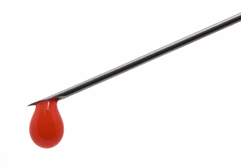The estimated rate of BBV transmission after sharps injury is widely publicised. For Hepatitis B Virus infections the risk is around 30%, for Hepatitis C 3% and for HIV infections around 0.3% risk. There are, however many variables that will affect these data.
The data refer more to healthcare professionals suffering sharps injury in the clinical setting. Some data exist to show the loss of infectivity of these bloodborne virus over time, particularly at ambient temperature and with the additional effects of sunlight and  dessication over time. Despite this, there is little to suggest that the risk diminishes over time at least over several, perhaps 7-10 days.
dessication over time. Despite this, there is little to suggest that the risk diminishes over time at least over several, perhaps 7-10 days.
Most clinical protocols use risk assessment to judge the need for specific antiviral treatment after sharps injury. Was the puncture deep or superficial? Did the would bleed? Was the needle a wide-bore hollow needle or some fine but solid point? Was the source patient known to be BBV negative or BBV positive, or was the source patient unknown?
This last criterion is particularly important: where the source patient is unknown it is most common to score the risk of BBV transmission as sufficiently high to warrant immediate prophylaxis and comprehensive follow-up by a specialist Infectious Diseases team.
This might be set against evidence of an obviously old needle, dried and with little evidence of bloodstaining. For some, this might be sufficient to ignore an injury, or to limit clinical follow-up, but is this wise?
In their paper “Acute hepatitis B infection following a community-acquired needlestick injury” (Journal of Infection 2011; 62: 487-9: doi:10.1016/j.jinf.2011.04.002), Res and Bowden describe a case of acute Hepatitis B infection occurring 2 months after a community-acquired needlestick injury. The patient had a history of incomplete vaccination and Hepatitis B vaccine booster was delayed. He did not receive immunoglobulin.
Transmission of blood-borne viruses in a non-clinical setting is exceedingly rare. The patient was a 26-year old cleaner who sustained a needlestick injury while cleaning out a roof gutter. Discarded injecting equipment was commonly found in the area. He was wearing protective leather gloves but after reaching into the gutter he felt the needle of a 1 ml syringe penetrate the palm of his right hand. There was no plunger in the barrel of the syringe and there was no blood visible. At day 74, Hepatitis B infection was confirmed.
This is only the second report of transmission of Hepatitis B from a community-acquired needlestick injury and only the first in an adult. The other case involved a 4-year old Spanish boy who developed acute Hepatitis B infection following an exposure to a needle that had been discarded by a neighbour.
The lessons here are that, while infection may be rare it is not unknown. It may occur after injury with items that are not ‘fresh’ and not visibly bloodstained. Leather gloves are not sharps resistant. Infection may not be apparent for a considerable time after follow-up, increasing the importance of recognition and reporting of all injuries, and of careful follow-up.
Under-reporting of sharps injury is common. With little concern given to injuries caused by items other than needles, or of blood and bloodstained body fluid exposures to the mouth or eyes, or to broken skin such as unrelated cuts and grazes or eczematous lesions, it is likely that some greater number of transmission events occur but that these have not been linked to some work-related exposure in waste handlers.
